Fibre Optic FBG Sensors for Monitoring of the Temperature of the Building Envelope
Abstract
:1. Introduction
2. Materials and Methods and Preliminary Testing
3. Results
3.1. Two-Layer Wall
3.2. Three-Layer Wall
4. Discussion
5. Conclusions
- It is demonstrated that the fibre optic technology based on multiplexed FBG sensors enables effective measurement of temperature in the building envelope. The thermal boundary conditions on the outside of the analysed envelope can be obtained by means of measurements performed using a thermographic camera. FBG sensors can be used instead of classical temperature sensors, especially if the latter types are damaged. The hybrid method of the measurement of temperature distributions consists of implementing various measuring methods, which enhances the effectiveness of performed measurements and may contribute to a reduction in the costs of conducting the experiment;
- The calibration tests demonstrate a linear dependence between temperature and the wavelength measured using fibre optic sensors;
- Differences are observed between the theoretical and the real temperature distribution in the building envelope for the ambient air relative humidity level of 40–50%;
- A correction factor is proposed to correct the theoretical temperature distribution in the building envelope. The factor makes it possible to eliminate the difference between the theoretical and the real temperature distribution;
- Considering the latest technological progress in the field of optical interrogators, the cost is comparable to classical methods of temperature measurements in the building wall. In fact, it can even be included in the low-cost group, while the computational cost is acceptable for large facilities;
- In the future, the system presented in the paper will enable comprehensive thermal and structural monitoring of building structures. The determined real thermal delays occurring in the wall will make it possible to optimise the building heating/cooling strategy. The knowledge of temperature distributions in the building walls depending on climatic conditions will enable the selection of a heating system suitable for a given wall configuration, which may reduce energy consumption.
Author Contributions
Funding
Institutional Review Board Statement
Informed Consent Statement
Data Availability Statement
Conflicts of Interest
References
- Ahola, S.; Lahdensivu, J. Long term monitoring of repaired external wall assembly. In Proceedings of the 11th Nordic Symposium on Building Physics (NSB2017), Trondheim, Norway, 11–14 June 2017. [Google Scholar]
- Marino, B.M.; Muñoz, N.; Thomas, L.P. Calculation of the external surface temperature of a multi-layer wall considering solar radiation effects. Energy Build. 2018, 174, 452–463. [Google Scholar] [CrossRef]
- Liu, T.; Sun, W.; Kou, H.; Yang, Z.; Meng, O.; Zheng, Y.; Wang, H.; Yang, X. Experimental Study of Leakage Monitoring of Diaphragm Walls Based on Distributed Optical Fiber Temperature Measurement Technology. Sensors 2019, 19, 2269. [Google Scholar] [CrossRef] [Green Version]
- Juarez, J.C.; Maier, E.W.; Choi, K.N.; Taylor, H.F. Distributed fiber-optic intrusion sensor system. J. Lightwave Technol. 2005, 23, 2081–2087. [Google Scholar] [CrossRef]
- Minardo, A.; Bernini, R.; Zeni, L. Distributed Temperature Sensing in Polymer Optical Fiber by BOFDA. IEEE Photonics Technol. Lett. 2014, 26, 387–390. [Google Scholar] [CrossRef]
- Bao, X.Y.; Liang, C. Recent progress in distributed fiber optic sensors. Sensors 2012, 12, 8601–8639. [Google Scholar] [CrossRef] [Green Version]
- Čápováa, K.; Velebila, L.; Včeláka, J.; Dvořákb, M.; Šašekb, L. Environmental Testing of a FBG Sensor System for Structural Health Monitoring of Building and Transport Structures. In Proceedings of the ICSI 2019 The 3rd International Conference on Structural Integrity, Procedia Structural Integrity, Funchal, Madeira, Portugal, 2–5 September 2019. [Google Scholar]
- Velebil, L.; Čápová, K.; Včelák, J.; Kuklík, P.; Demuth, J.; Dvořák, M. Mechanical Stress Monitoring of Timber and Concrete Structures by Fibre Optic Sensors. In Proceedings of the WCTE 2018, Seoul, Korea, 20–23 August 2018. [Google Scholar]
- Kersey, A.D. A Review of Recent Developments in Fiber Optic Sensor Technology. Opt. Fiber Technol. 1996, 2, 291–317. [Google Scholar] [CrossRef]
- Othonos, A.; Kyriacos, K. Fiber Bragg Gratings: Fundamentals and Applications in Telecomunications and Sensing; Artech House Print on Demand: Norwood, MA, USA, 1999; ISBN 0-89006-344-3. [Google Scholar]
- Chong, K.; Carino, N.; Washer, G. Health monitoring of civil infrastructures. Smart Mater. Struct. 2003, 12, 483. [Google Scholar] [CrossRef]
- Ansari, F. Fiber optic health monitoring of civil structures using long gage and acoustic sensors. Smart Mater. Struct. 2005, 14, S1–S7. [Google Scholar] [CrossRef]
- Cosentino, P.; Eckroth, W.; Grossman, B. Analysis of fiber optic traffic sensors in flexible pavements. J. Transp. Eng. 2003, 129, 549–557. [Google Scholar] [CrossRef]
- Liu, W.; Wang, H.; Zhou, Z.; Li, S.; Ni, Y.; Wang, G. Optical fiber based sensing system design for the health monitoring of multi-layered pavement structure. In Proceedings of the SPIE 8199, 2011 International Conference on Optical Instruments and Technology: Optical Sensors and Applications, Beijing, China, 6–9 November 2011. [Google Scholar]
- Zhong, R.; Guo, R.; Deng, W. Optical-fiber-based smart concrete thermal integrity profiling: An example of concrete shaft. Adv. Mater. Sci. Eng. 2018, 2018, 9290306. [Google Scholar] [CrossRef] [Green Version]
- Sun, X.; Du, Y.; Liao, W.; Ma, H.; Huang, J. Measuring the heterogeneity of cement paste by truly distributed optical fiber sensors. Constr. Build. Mater. 2019, 225, 765–771. [Google Scholar] [CrossRef]
- Liao, W.; Zhuang, Y.; Zeng, C.; Deng, W.; Huang, J.; Ma, H. Fiber Optic Sensors Enabled Monitoring of Thermal Curling of Concrete Pavement Slab: Temperature, Strain and Inclination. Measurement 2020, 165, 108203. [Google Scholar] [CrossRef]
- Weng, X.; Zhu, H.-H.; Chen, J.; Liang, D.; Shi, B.; Zhang, C.-C. Experimental investigation of pavement behavior after embankment widening using a fiber optic sensor network. Struct. Health Monit. Int. J. 2014, 14, 46–56. [Google Scholar] [CrossRef]
- Loizos, A.; Plati, C.; Papavasiliou, V. Fiber optic sensors for assessing strains in cold in-place recycled pavements. Int. J. Pavement Eng. 2013, 14, 125–133. [Google Scholar] [CrossRef]
- Wang, J.; Tang, J.; Chang, H. Fiber Bragg grating sensors for use in pavement structural strain-temperature monitoring. In Proceedings of the SPIE 6174, Smart Structures and Materials 2006: Sensors and Smart Structures Technologies for Civil, Mechanical, and Aerospace Systems, San Diego, CA, USA, 27–28 February 2006. [Google Scholar]
- Hirayama, N.; Sano, Y. Fiber Bragg grating temperature sensor for practical use. ISA Trans. 2000, 39, 169–173. [Google Scholar] [CrossRef]
- Juraszek, J. Fiber Bragg Sensors on Strain Analysis of Power Transmission Lines. Materials 2020, 13, 1559. [Google Scholar] [CrossRef] [PubMed] [Green Version]
- Juraszek, J. Hoisting machine brake linkage strain. Arch. Min. Sci. 2018, 63, 583–597. [Google Scholar]
- Zhang, B.; Zhang, M.; Hong, D. Land surface temperature retrieval from Landsat 8 OLI/TIRS images based on back-propagation neural network. Indoor Built Environ. 2019, 30, 1–17. [Google Scholar] [CrossRef]
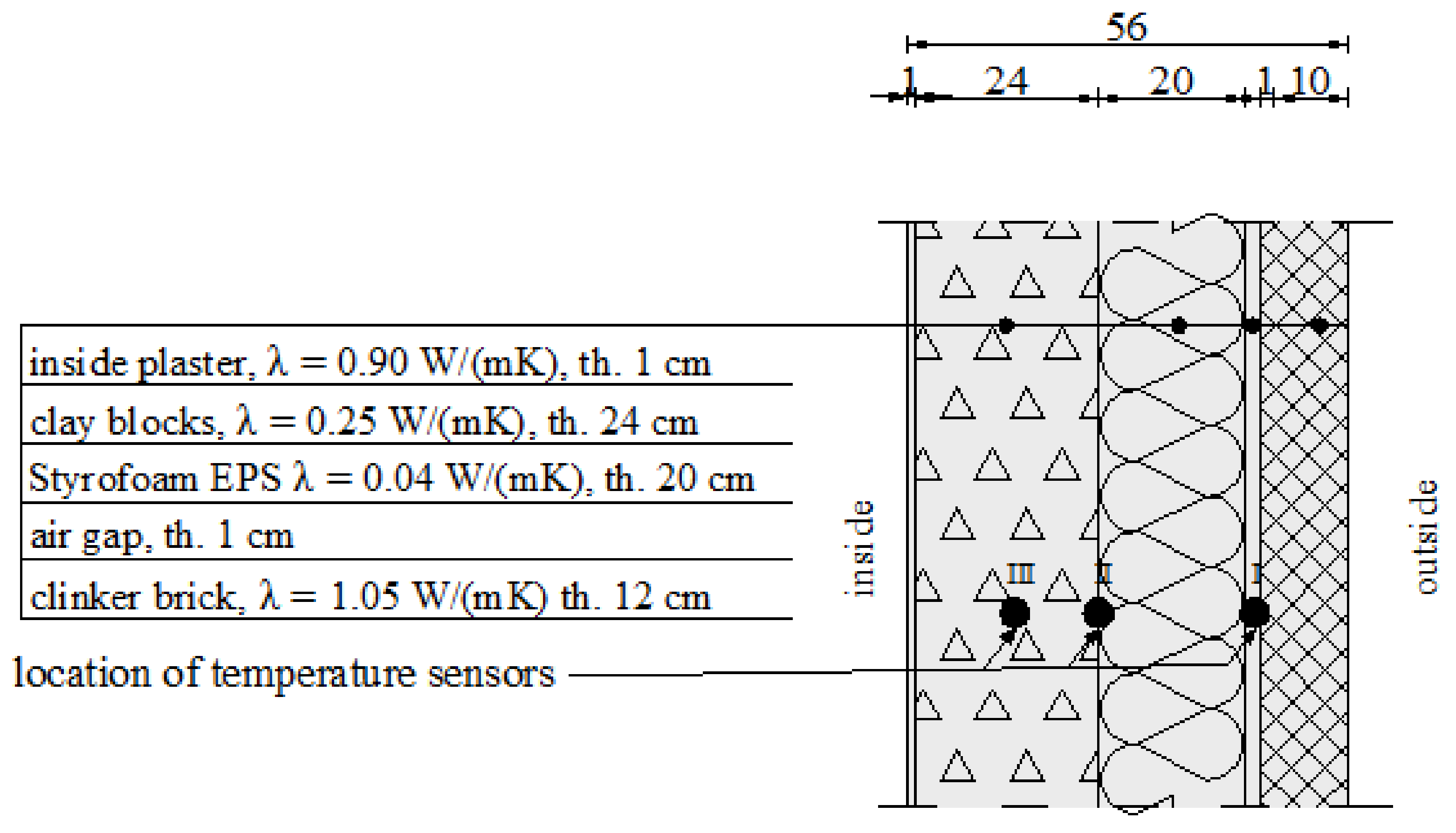





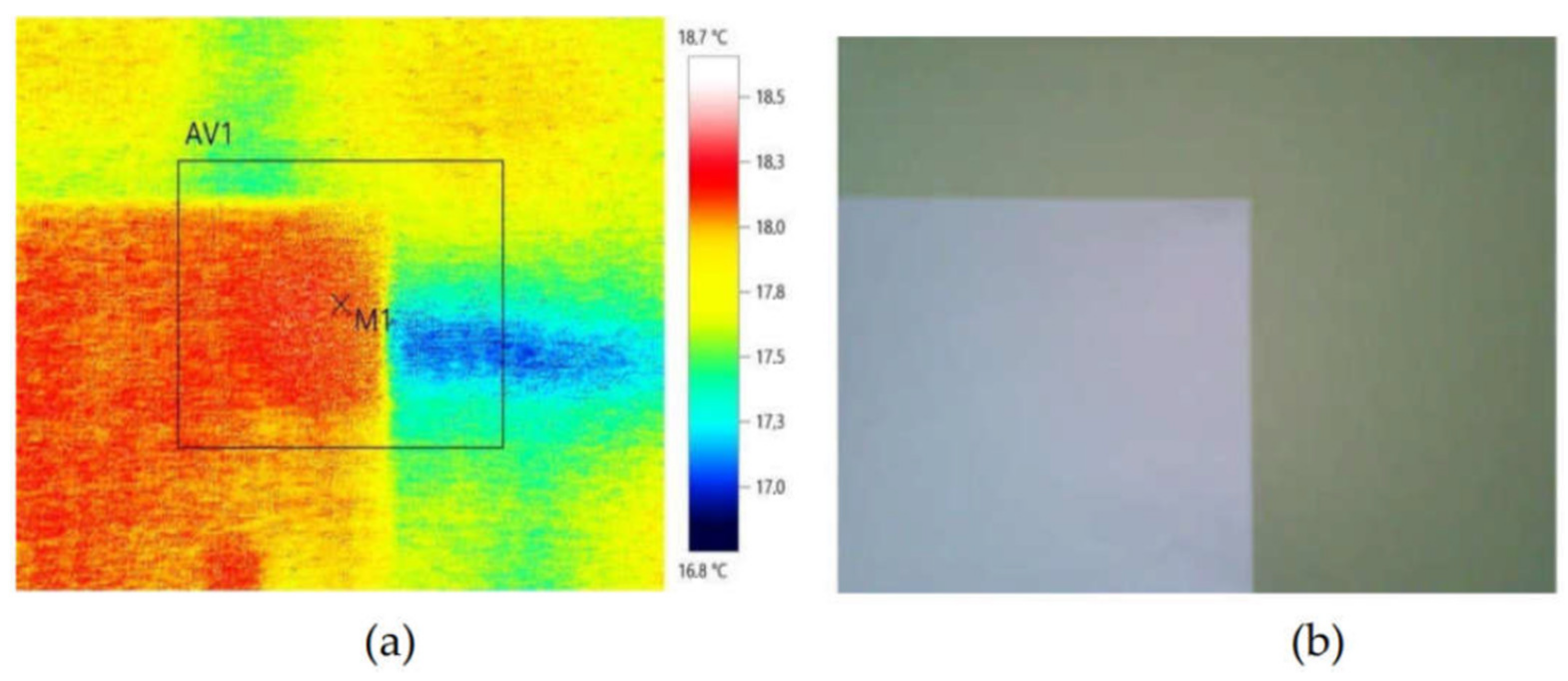
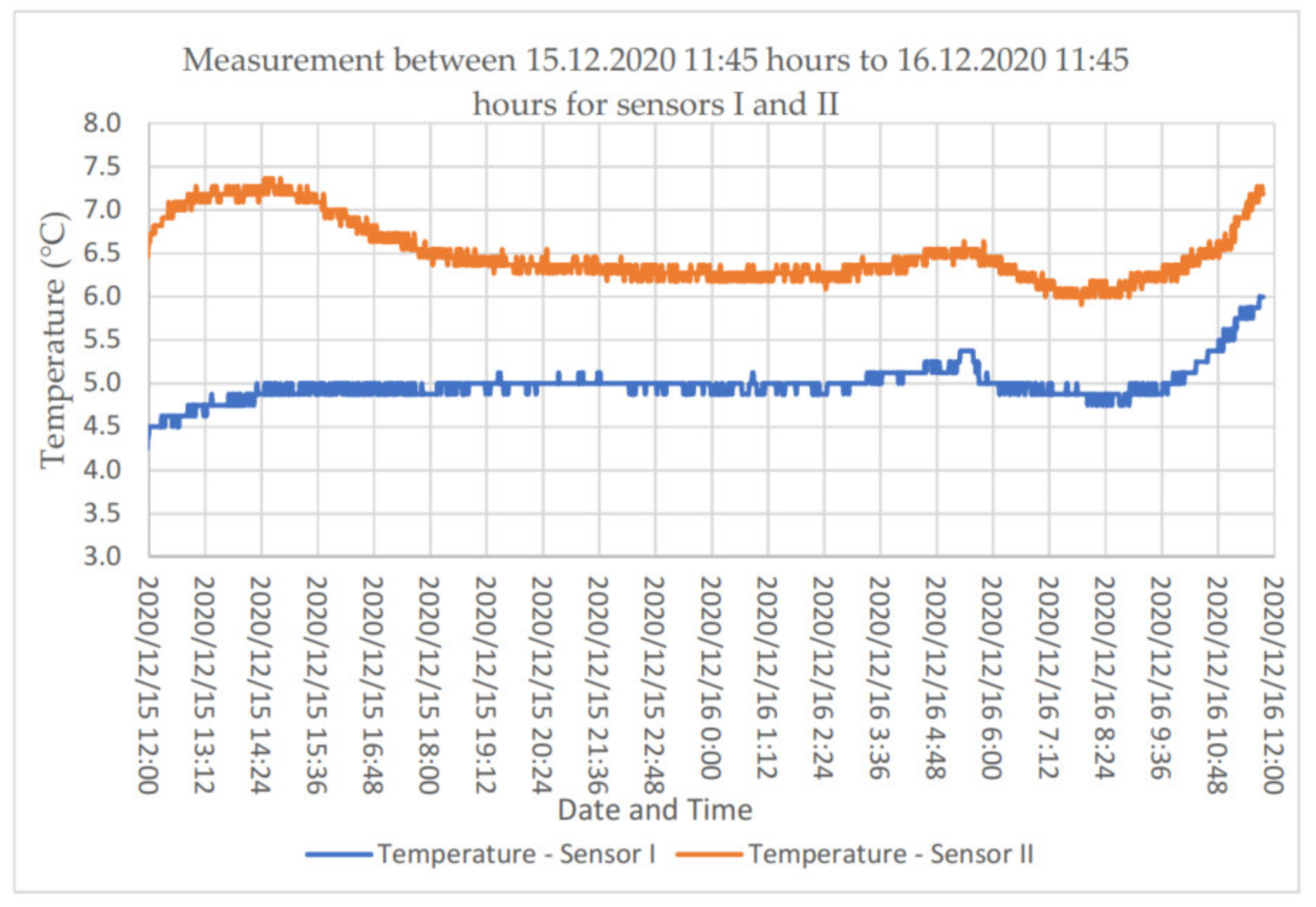

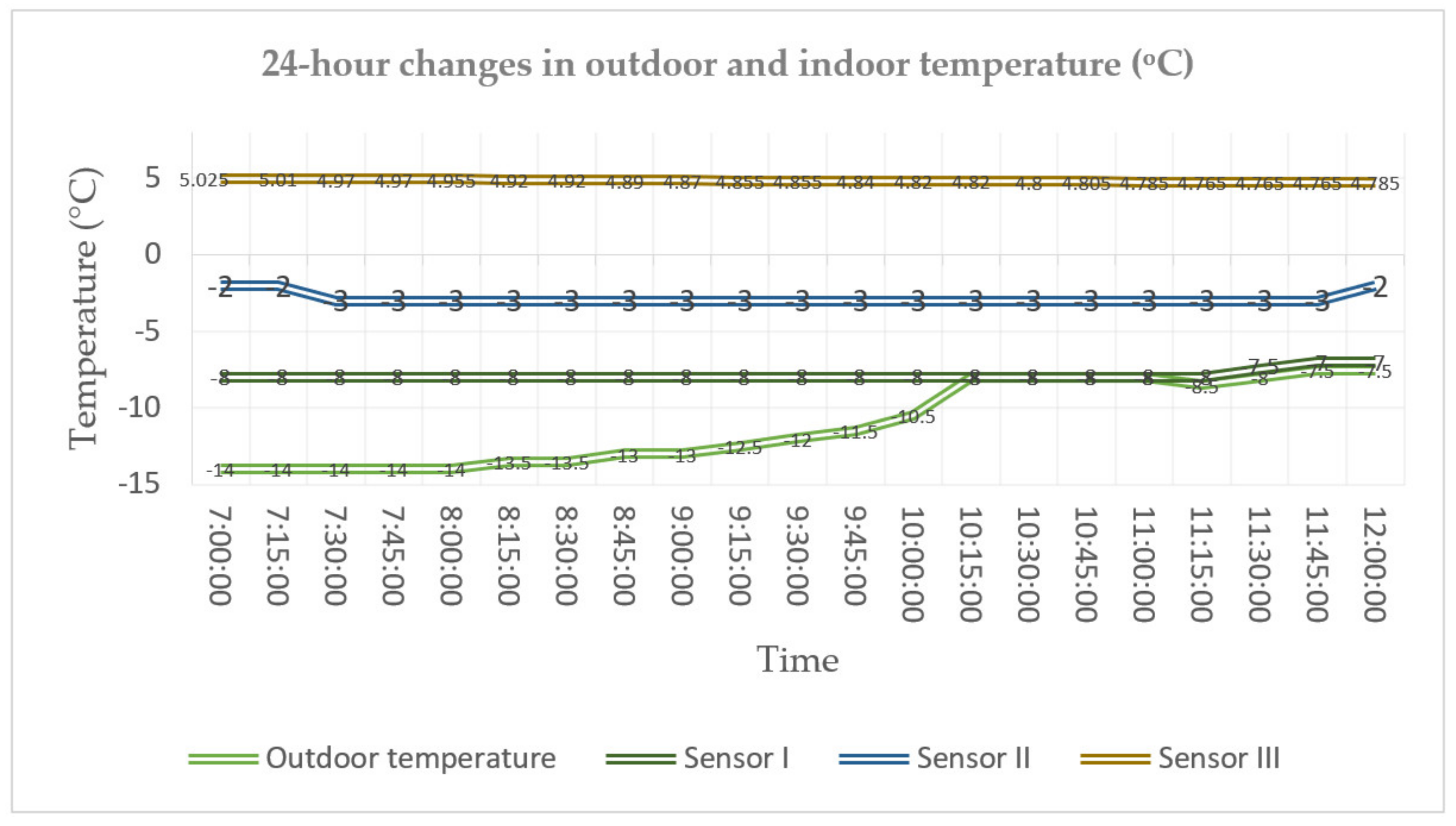
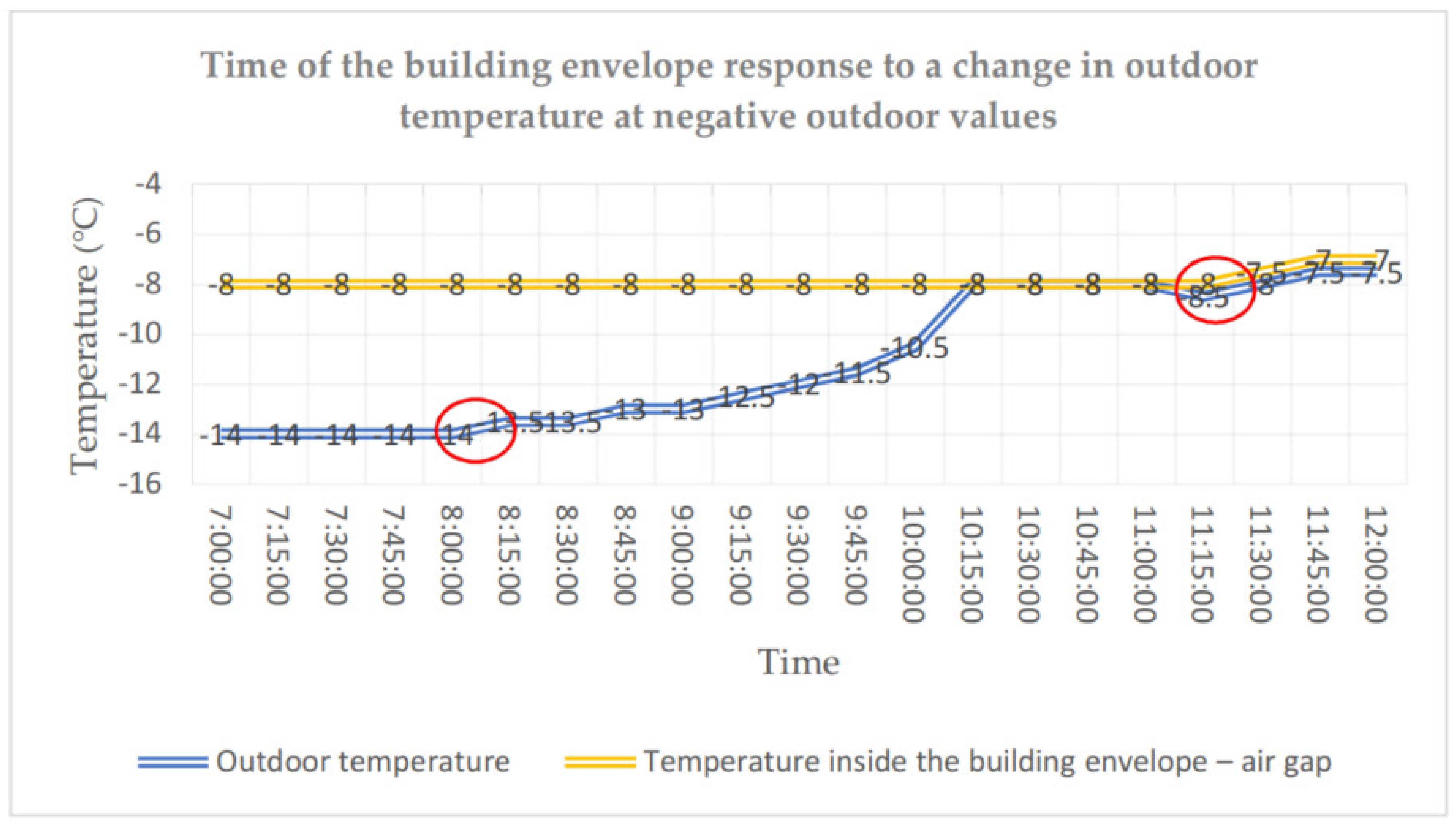
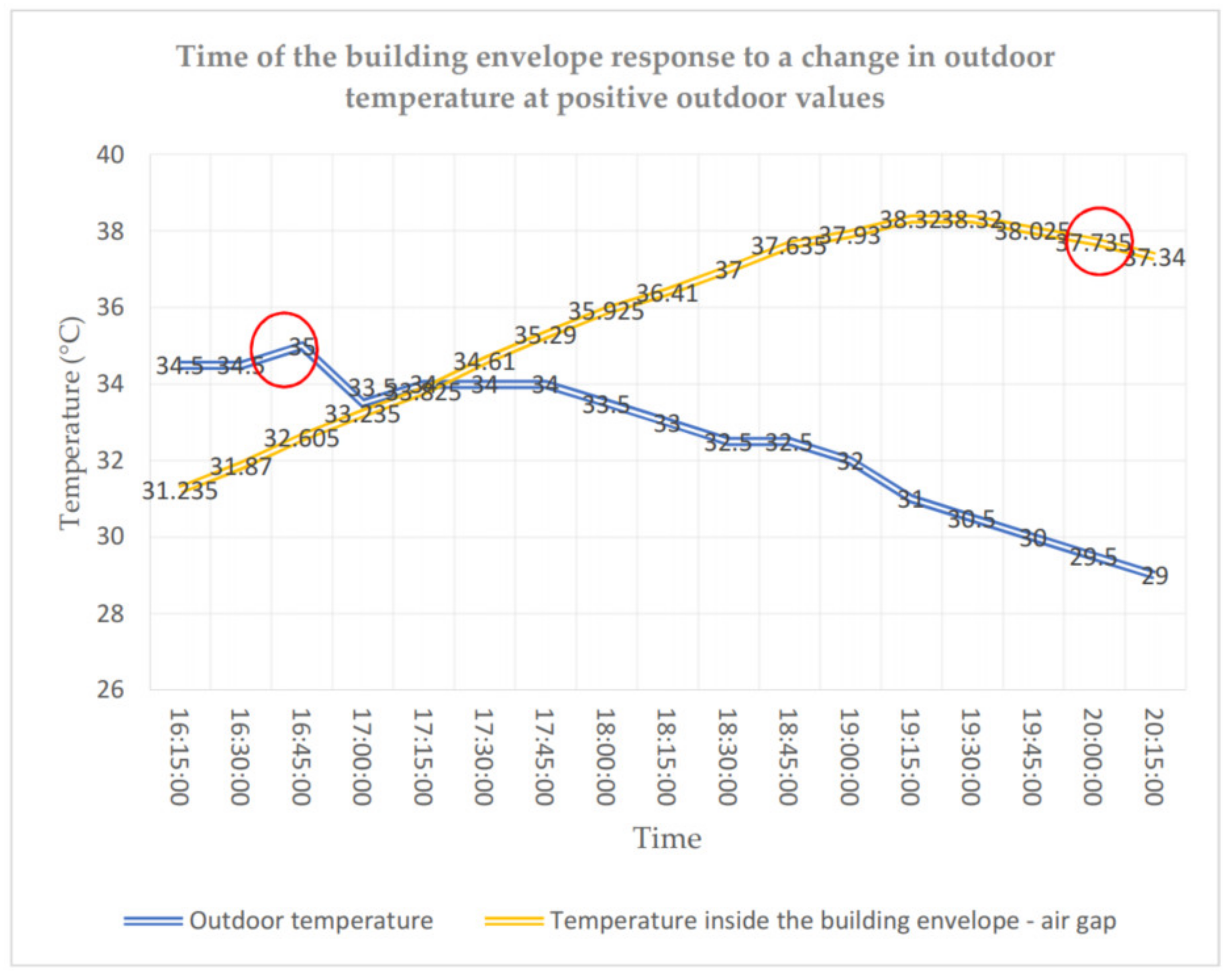



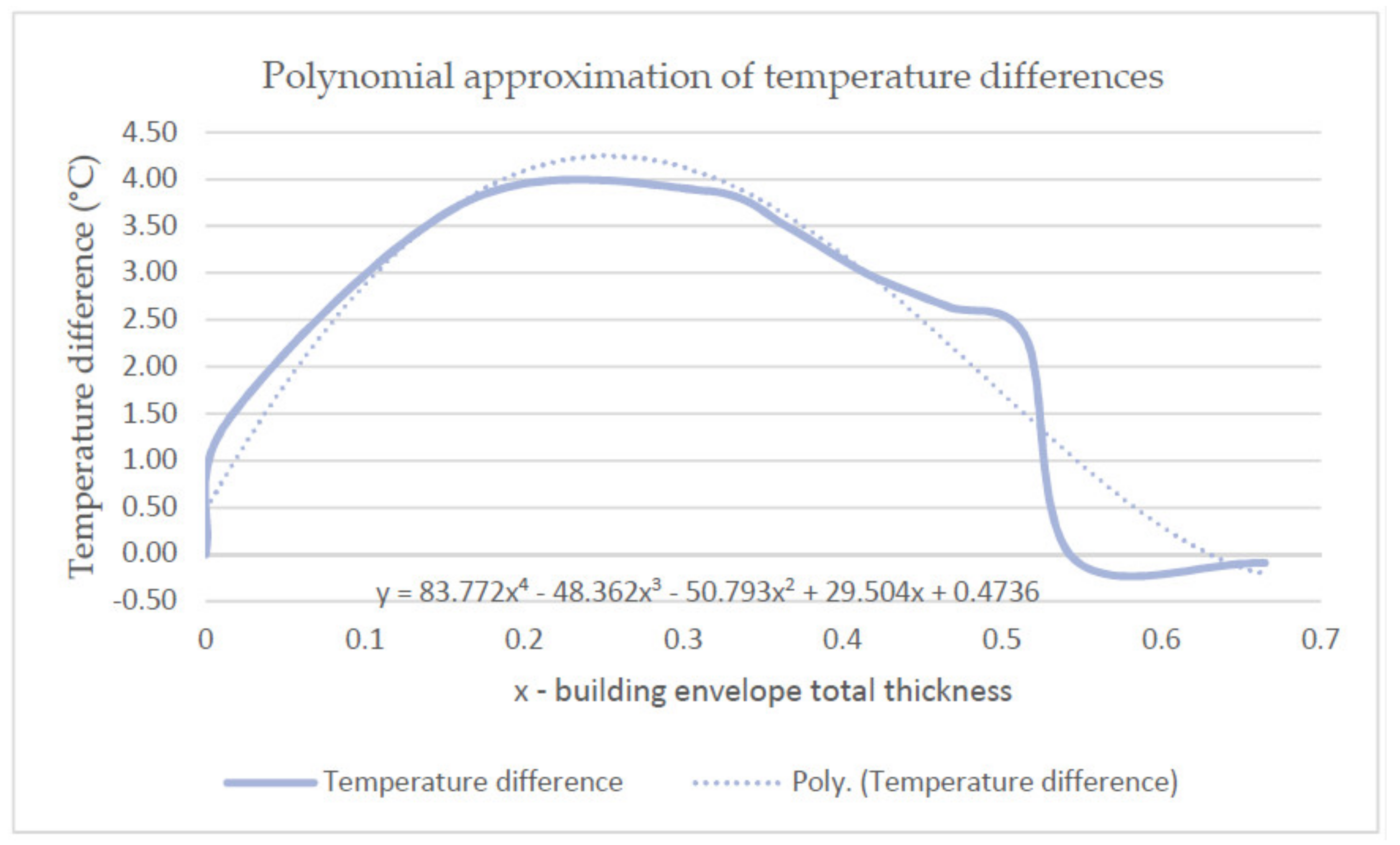
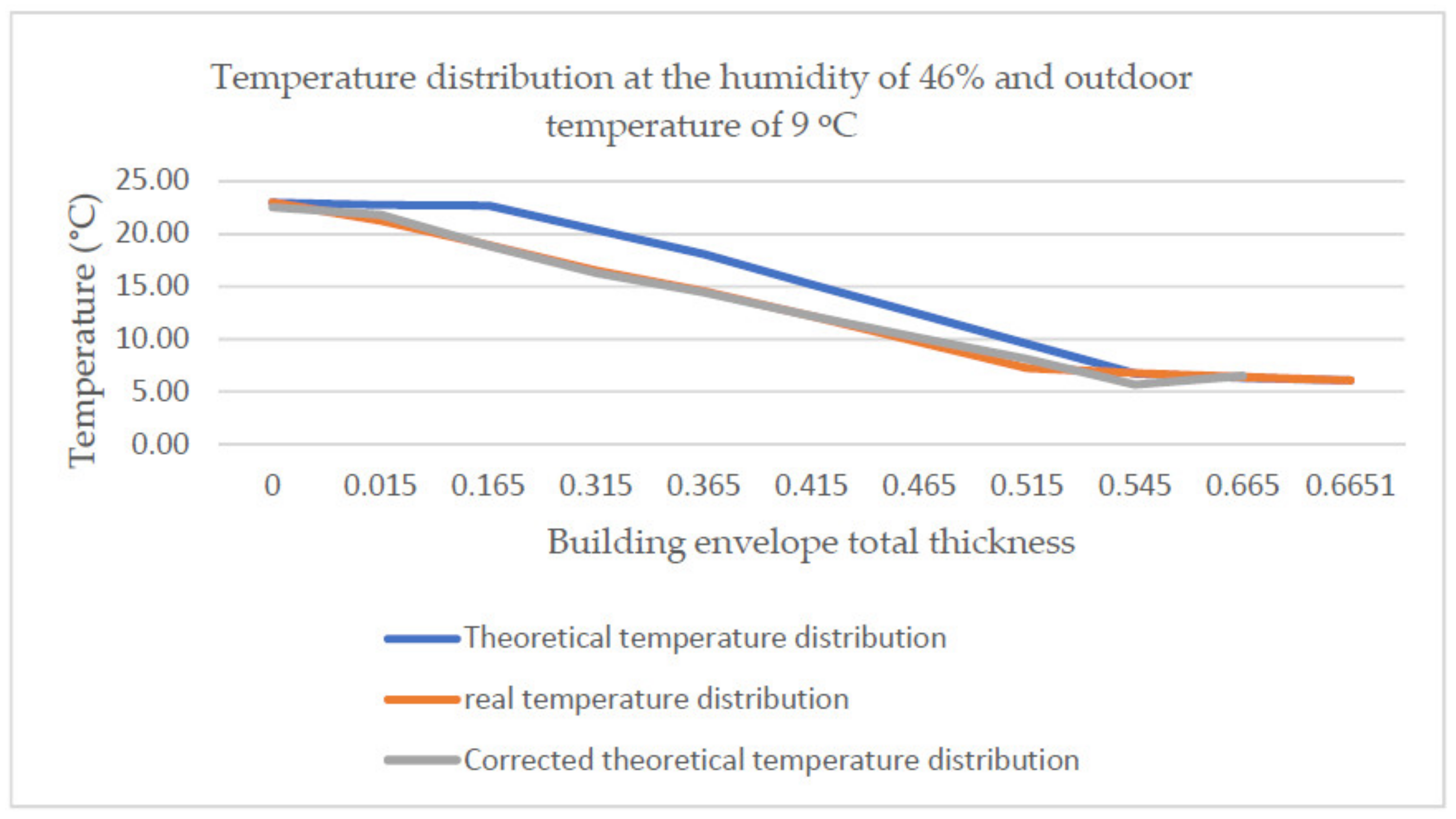
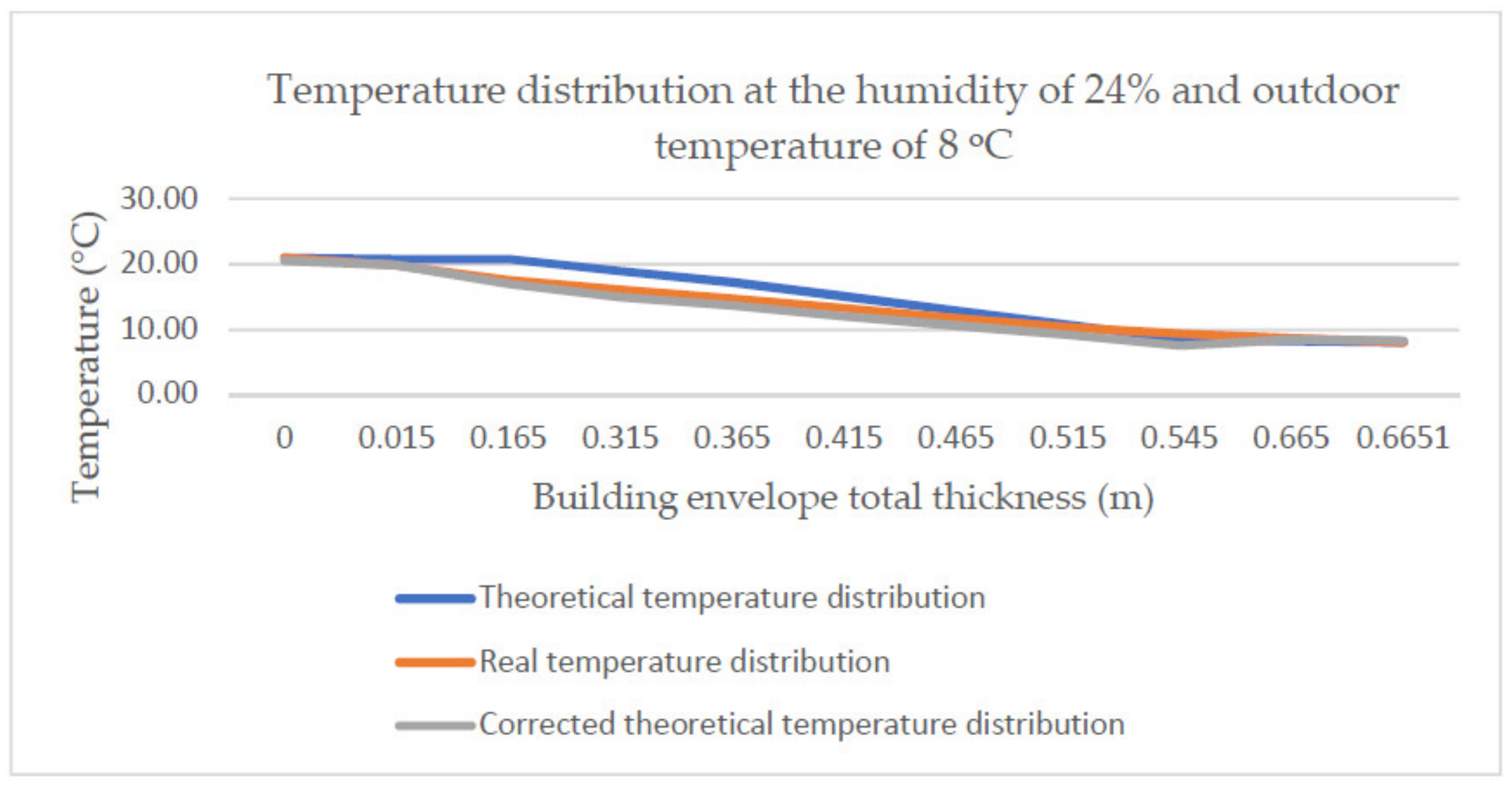
| Temperature Accuracy (Guaranteed) | Temperature Accuracy (Typical) | Temperature Precision (Guaranteed) | Temperature Precision (Typical) | Ingress Protection Rating |
|---|---|---|---|---|
| 1 °C | <1 °C | ±0.3 °C | ±0.2 °C | IP 67 |
| Measurand | Description |
|---|---|
| T (°C) | Temperature |
| λT,act (nm) | Actual temp. wavelength |
| λT,ref (nm) | Reference temp. wavelength |
| TS1 (°C) | Temperature coefficient 1 |
| TS2 (°C) | Temperature coefficient 2 |
| TS3 (°C) | Temperature coefficient 3 |
| Ts1 (°C) | Ts2 (°C) | Ts3 (°C) | λΤ,ref (nm) |
|---|---|---|---|
| −2,477,681.366 | 52,768.19076 | 22.50476755 | 1,548,514.494 |
| −2,569,888.019 | 53,819.29229 | 22.50525754 | 1,548,477.574 |
| −2,311,1030.106 | 53,588.17046 | 22.5027883 | 1,548,633.785 |
| Date: 12 January 2021 | Time: 8:58:37 | Outdoor Temperature: −3.1 °C |
|---|---|---|
| Measured quantity | Temperature (°C) | |
| Measuring point 1 | −6.5 | |
| Measuring point 2 | −7.1 | |
| Mean value of the surface measurements | −5.9 | |
| Temperature Sensor in the Envelope | Linear Correlation (p < 0.05000 N = 2689) in the Winter Period |
|---|---|
| Outdoor Temperature | |
| Sensor I | 0.937465 |
| Sensor II | 0.843755 |
| Sensor III | 0.760560 |
| Theoretical Temperature on the Interface of Layers | Real Temperature | Temperature Difference | Polynomial Approximation of Differences (Correction) | Post-Correction Temperature on the Interface of Layers |
|---|---|---|---|---|
| 23.00 | 23.00 | 0.00 | 0.47 | 22.53 |
| 22.72 | 21.27 | 1.45 | 0.90 | 21.82 |
| 22.68 | 18.91 | 3.77 | 3.80 | 18.88 |
| 20.37 | 16.50 | 3.88 | 4.04 | 16.33 |
| 18.06 | 14.57 | 3.50 | 3.61 | 14.45 |
| 15.22 | 12.23 | 2.99 | 3.00 | 12.23 |
| 12.39 | 9.74 | 2.65 | 2.26 | 10.12 |
| 9.55 | 7.25 | 2.30 | 1.48 | 8.07 |
| 6.71 | 6.76 | −0.05 | 1.03 | 5.68 |
| 6.33 | 6.42 | −0.09 | −0.21 | 6.54 |
| 6.09 | 6.09 | 0.00 | −0.21 | 6.29 |
Publisher’s Note: MDPI stays neutral with regard to jurisdictional claims in published maps and institutional affiliations. |
© 2021 by the authors. Licensee MDPI, Basel, Switzerland. This article is an open access article distributed under the terms and conditions of the Creative Commons Attribution (CC BY) license (http://creativecommons.org/licenses/by/4.0/).
Share and Cite
Juraszek, J.; Antonik-Popiołek, P. Fibre Optic FBG Sensors for Monitoring of the Temperature of the Building Envelope. Materials 2021, 14, 1207. https://doi.org/10.3390/ma14051207
Juraszek J, Antonik-Popiołek P. Fibre Optic FBG Sensors for Monitoring of the Temperature of the Building Envelope. Materials. 2021; 14(5):1207. https://doi.org/10.3390/ma14051207
Chicago/Turabian StyleJuraszek, Janusz, and Patrycja Antonik-Popiołek. 2021. "Fibre Optic FBG Sensors for Monitoring of the Temperature of the Building Envelope" Materials 14, no. 5: 1207. https://doi.org/10.3390/ma14051207
APA StyleJuraszek, J., & Antonik-Popiołek, P. (2021). Fibre Optic FBG Sensors for Monitoring of the Temperature of the Building Envelope. Materials, 14(5), 1207. https://doi.org/10.3390/ma14051207





